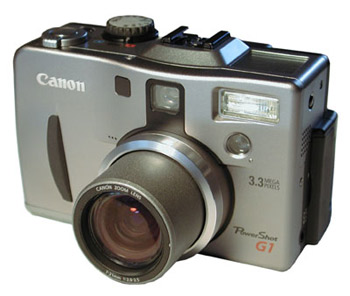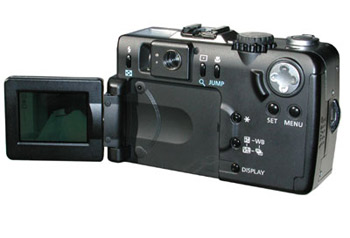Canon’s G1: RAW Power and Good Design

If you’ve been considering the purchase of a 3-megapixel, high-quality digital camera, then we’ve got some bad news: Canon has just made your buying decision much more difficult. With the new PowerShot G1, Canon has taken aim at the Nikon Coolpix 990, Olympus C-3030 and Epson 3000Z and, in many instances, leapfrogged the competition altogether.
Following the design of the very successful PowerShot S10 and S20, the G1 looks like a fairly typical 35mm point-and-shoot camera. The discerning shopper, however, will be impressed with the G1’s differentiating features, such as its tilt/swivel LCD screen, RAW data mode, and slow ISO rating. These features, combined with the unit’s very competitive image quality, make the G1 a camera that deserves a good long look.
Kicking the Tires
Weighing in at 14 ounces with measurements about the same as a thick Walkman, the G1 fits easily into an oversized coat or jacket pocket. Like the Olympus 3030 and Epson 3000, the G1 features a 3x zoom lens that extends and retracts when you turn the camera on and off. Though a retractable lens makes for a smaller camera that’s more easily stored, it also can put a damper on quick shooting, because you have to wait for the lens to extend. The G1 lens extension is not noticeably faster or slower than its competition; the camera is ready to shoot about 6 seconds after powering up.

The G1’s controls are very simple. A swivel zoom control is mounted around the camera’s top-mounted shutter release, and a simple dial doubles as a power switch and selector for the camera’s different shooting modes. On the top of the camera a hot shoe provides full compatibility with Canon EX-series Speedlight flashes, and an LCD status display provides far more information than that of any other digital camera I’ve seen.
The back of the camera provides a few simple controls for the rest of the camera’s functions. A four-way rocker switch makes for easy navigation of the camera’s on-screen menus, and simple push-buttons activate the menus and LCD screen. Dedicated buttons let you control flash mode, metering mode, macro mode, exposure lock, burst mode, and manual focus.
Exposure compensation, white balance, auto-bracketing, and flash power settings are all accessed through a single button. Repeatedly pressing the button cycles through the four different controls, and the LCD status screen displays the current setting. Many digital cameras require use of the battery-draining LCD monitor even for these simple tasks.
The G1’s most distinctive feature is its LCD screen which, like Canon’s older PowerShot Pro70, features a flip-out mechanism that lets you tilt and swivel the display into many positions. Offering similar flexibility to Nikon’s split-body Coolpix design, the G1’s LCD lets you shoot from a variety of angles and can even be swiveled completely around for self-portraits. When not in use, the LCD can be closed against the camera’s body where it’s protected from scratches and fingerprints.

In addition to its flexible design, the G1’s LCD offers extraordinary image quality, thanks largely to a special anti-glare coating that makes the screen easily useable in direct sunlight. The LCD offers a very good approximation of final colors and saturation, making it a reasonable tool for assessing exposure.
As with all cameras in its class, however, the G1 provides a tiny and inaccurate optical viewfinder. Offering marginal coverage and low image quality, the G1’s optical viewfinder is cheesy enough to make you always want to use the LCD display to frame your images.
A solid, metal tripod mount is included on the bottom of the camera and is positioned so that you can still get to the battery even when the camera is mounted. Unfortunately, such positioning requires that the mount be slightly off-axis from the lens, making for hassles when shooting panoramas.
The left side of the camera houses the unit’s video out port (which is NTSC/PAL switchable), battery charging port, and digital I/O port. The G1 supports both USB and standard serial connections, and the camera ships with a USB cable included (serial cable is optional). These ports are covered with a small rubber door attached to the body of the camera using what seems to be the flimsiest connector that Canon engineers could find. It’s difficult to say whether or not this cover will last.
Long Life and Good Memory
The G1 offers the best storage capability of any camera in its class. While the Olympus 3030 continues to use lower-capacity SmartMedia cards and Nikon and Epson offer support for Type I CompactFlash cards, the G1 supports both Type I and Type II CompactFlash cards. Type I flash memory cards currently offer capacities up to 256 MB, and Type II support allows you to use IBM Microdrives — tiny hard drives with capacities as high as 1GB.
As with other Canon cameras, the G1 uses a proprietary Canon battery pack. There are a lot of things wrong with proprietary power sources. They’re typically expensive and you can’t pick up more of them at the corner 7-Eleven when your batteries die in the field. An optional two-battery charger is available (part #CR-560). Despite these complaints, the G1 battery is amazing! Light in weight and fast to charge, the G1’s Lithium Ion battery simply never seems to die.
Shooting In Style
The G1 is a comfortable camera, providing all of the features you’d expect from an offering in its class. In addition to automatic and program modes, the G1 also offers shutter-priority, aperture-priority and full-manual modes. A number of predefined exposure modes are also included. Portrait mode, for example, locks the camera into a wide aperture for shallow depth of field, and Pan Focus mode locks the camera into a narrow aperture for landscape shooting. All of these modes are easily selected from the camera’s top-mounted mode dial.
When in either priority mode or full-manual mode, you can easily select shutter speed or aperture using the camera’s four-position rocker switch. The camera always displays shutter speed and aperture in its LCD status display as well as in its LCD viewfinder.
The G1 provides a fast f2 to 2.5 lens with a zoom range of 34 to 102mm (35mm equivalent). When manually controlling the shutter speed, though, it’s important to note that the G1 must shoot at f8 on any speed faster than 1/500th of a second. This is because the G1 uses its iris as a mechanical shutter, and to open and close the iris at such high speeds, it needs to be stopped down. For most uses, this limitation shouldn’t be a problem.
Canon has included a number of handy shooting tools, including an auto-bracketing feature, Canon’s excellent StitchAssist mode for panorama shooting, and a movie mode that can shoot as much as 30 seconds of 15 fps video with monaural sound.
The G1’s menu hierarchy is well organized and easy to navigate though somewhat overly layered. For example, deleting a single image in playback mode requires four button presses.
The G1 offers shot-to-shot performance that’s comparable to that of its main competition, and shutter lag times are acceptable — well under one second on our tests. In general, the G1 feels a tiny bit slower than the Coolpix 990, but definitely faster than the Epson 3000Z. One area that could use a performance boost is the responsiveness of the camera’s Exposure Compensation controls. The camera often requires a second or two to register a change in settings.
Canon offers a number of custom lens attachments that screw on to the front of the lens with the help of a special adapter ring. Both the Wide Converter and Telephoto adapter performed impressively. The Wide converter extends the G1’s wide angle by .8x to 27mm, and the telephoto converter extends the G1’s longest focal length to 153mm. Both adapters provide excellent optics and far less distortion than expected.
If you’re hoping that these add-ons are a good substitute for true, interchangeable lenses, however, you’re out of luck. Though their quality is very good, working with G1 lens attachments can be a bit of a hassle. To connect them, you must unscrew a ring that surrounds the camera’s lens and protects the attachment threads. The adapter — with the step-up ring — can then be screwed on. So, in addition to the camera’s lens cap and the caps and covers from the adapters, you also have to try not to lose the special thread cover.
Once you’ve got the adapters on, the optical viewfinder will no longer be usable, because the G1 does not use a through-the-lens viewfinder.
Despite these complaints, Canon’s adapters are a worthwhile investment if you want more shooting flexibility.
This article was last modified on January 18, 2023
This article was first published on December 6, 2000




